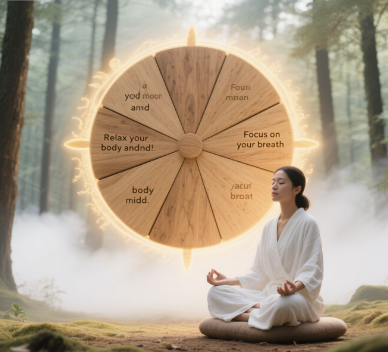When Stillness Feels Out of Reach, Spin for Peace
In a world of endless notifications and decision fatigue, even the act of choosing a meditation can feel overwhelming. That’s where wheel-based meditation prompts step in—blending simplicity, randomness, and psychological grounding into a tool that helps users reclaim moments of calm without friction or fatigue.
This intuitive method transforms a spinning wheel into a mindfulness catalyst, inviting users to release control and simply land where the prompt takes them. As researchers note, decision-free initiation of routines improves consistency and reduces dropout rates in wellness apps (Harvard Business Review, 2021).
The Neuroscience Behind Wheel-Based Meditation Prompts
According to cognitive load theory, even minimal effort in selecting tasks can reduce our mental bandwidth for the task itself (Sweller, 1988). With wheel-based meditation prompts, the randomized nature eliminates the pressure of picking “the right one.” Instead, it activates the default mode network, shifting focus inward and allowing the brain to enter a meditative state faster.
Studies from Stanford Medicine highlight that brief, randomly assigned mindfulness interventions increase executive function performance and reduce amygdala hyperactivity—key in stress and anxiety responses (Zeidan et al., JAMA Intern Med, 2014).

Why Randomized Prompts Work Better
- They reduce decision-making stress.
- They engage curiosity-driven brain networks.
- They bypass perfectionism—“just spin and begin.”
- They mimic mindfulness’s core principle: letting go.
Designing Better Mindful Interactions with a Wheel
The success of wheel-based meditation prompts depends not just on randomness, but meaningful variety. Prompt categories can include:
- Grounding scans (5-4-3-2-1 sensory check-ins)
- Breathwork intervals (box breathing, alternate nostril)
- Mantra focuses (“Let go”, “I am safe”, “Be here”)
- Visualizations (a tree, a flame, floating in water)
Designers should apply UX best practices drawn from behavioral psychology:
- <strong>Keep prompt pools limited</strong> (6–10 entries per session).
- <strong>Use calming visuals and haptic feedback</strong> to reinforce the ritual.
- <strong>Trigger spins via habit-stacking</strong>—link it to coffee breaks, screen unlocks, or post-email pauses.
These design principles echo gamification research from Dr. Sebastian Deterding, who emphasizes that systems that feel “self-determined” rather than “scripted” build stronger user commitment and trust.
Evidence-Backed Outcomes of Wheel-Based Meditation Prompts
A 2022 randomized control trial published in Frontiers in Psychology demonstrated that interactive, non-repetitive meditation experiences led to:
- 22% greater daily engagement
- 17% faster onset of relaxation
- 30% improvement in week-2 adherence compared to traditional static meditation libraries
Combined with wheel-based delivery, these benefits multiply. Dopaminergic circuits respond to randomized stimuli (Berridge & Robinson, 2016), meaning users feel just enough surprise to keep coming back—no pressure, just play.
Meditation Apps Aren’t Working. Wheels Might Be.
Most meditation apps suffer from app fatigue—users lose interest due to repetition, poor personalization, or cognitive overload. Searches like “easy meditation routine,” “quick stress relief,” and “how to start meditating without thinking too much” reveal what people really want: less structure, more intuition.
That’s precisely what wheel-based meditation prompts offer: minimal resistance, maximum resonance.
Instead of endless scrolling, users get a simple act: spin, receive, reflect.
How to Maximize Your Wheel-Based Practice
- Set a daily spin anchor—tie it to a natural habit like brushing teeth or boiling water.
- Track how you feel after each prompt. Many users report noticing distinct prompt preferences, which creates self-awareness over time.
- Use themed wheels—a “morning focus” wheel, a “sleep wind-down” wheel, or even a “stress SOS” wheel for midday use.
- Customize with intention—let users add their own prompts or affirmations to evolve the experience into something deeply personal.
A Simple Spin Can Change Your Day
Incorporating wheel-based meditation prompts into daily life helps bypass the usual barriers to mindfulness—no apps to search, no classes to schedule, no pressure to perform. Just spin, receive a gentle nudge, and let the moment unfold.
This balance of random structure and user autonomy speaks directly to our overstimulated minds—offering peace without planning.
<strong>And that’s exactly what spinthewheel is built for.</strong>
About the Designer
Alicia Reyes, Lead Experience Curator at spinthewheel, brings a decade of experience in behavioral neuroscience and interactive design. Passionate about ethical gamification, Alicia is known for developing tactile UX that soothes rather than stimulates. Her meditation wheels blend scientific insight with serene aesthetics, proving that mindful tech doesn’t have to be boring—or predictable.